Pheasants are heavy, ground-feeding birds from the same order as turkeys, chickens, and other landfowl. Pheasants have been hunted for meat for over 200 years in the United States, and longer in other parts of the world. But their beauty and elegance are often underrated as a group. Take a look at these ten beautiful types of pheasants and discover their locations, habitats, and behavior.
Golden Pheasant Golden pheasants are unmistakable with their golden crests and bright red bodies. They also feature orange, yellow, blue, black, and tan colors. They are native to the mountains of Western China.
Golden pheasants are unmistakable with their golden crests and bright red bodies. They also feature orange, yellow, blue, black, and tan colors. They are native to the mountains of Western China.
The golden pheasant, also known as the rainbow pheasant, is one of the most beautiful pheasant species in the world. Adult males are unmistakable with their golden crests and bright red bodies. They also feature colors in orange, yellow, blue, black, and tan. Females lack showy colors and, instead, have mottled brown plumage. These birds are native to the mountains of Western China, but many populations have been introduced to other countries, such as Canada, the United States, and Mexico. You can also find them in the dense forests of England. They search for leaves, grain, and invertebrates on the ground and roost in trees at night.
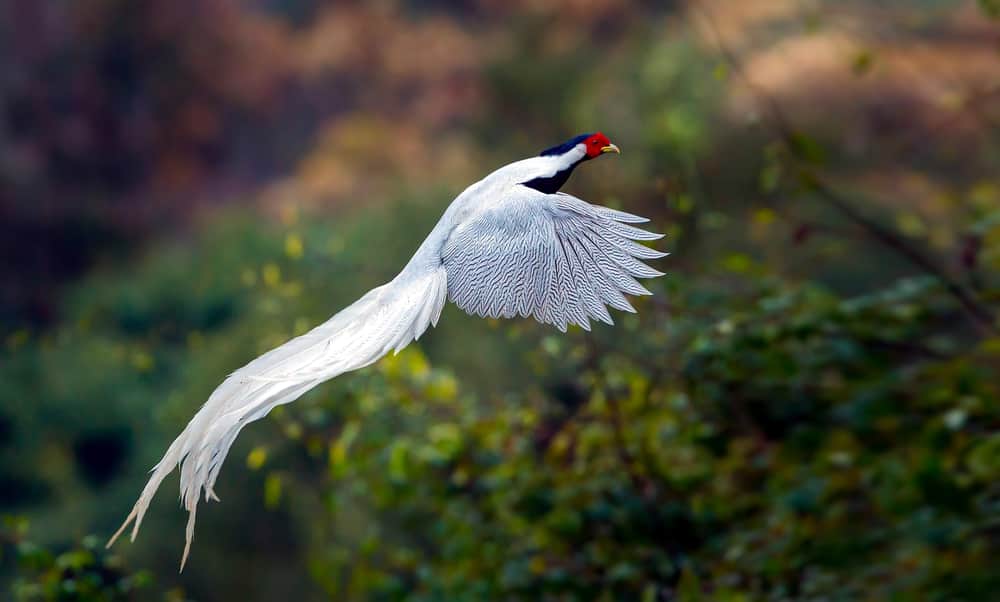 Silver pheasants have silvery-white upperparts and glossy bluish-black undersides. They also have red face skin, pale bills, and long, wispy tails.
Silver pheasants have silvery-white upperparts and glossy bluish-black undersides. They also have red face skin, pale bills, and long, wispy tails.
Found in the forested mountains of Southeast Asia and Southern China, the silver pheasant stands out in its green vegetated environment. They are large pheasants, but there are 15 subspecies, and each has variations in size and color. Males have silvery-white upperparts and glossy bluish-black undersides. They also have red face skin, pale bills, and long, wispy tails. Females have shorter tails and overall brown plumage. The species as a whole is common in aviculture and the wild. But some subspecies are rare and threatened, especially those found in Laos and Vietnam.
Kalij Pheasant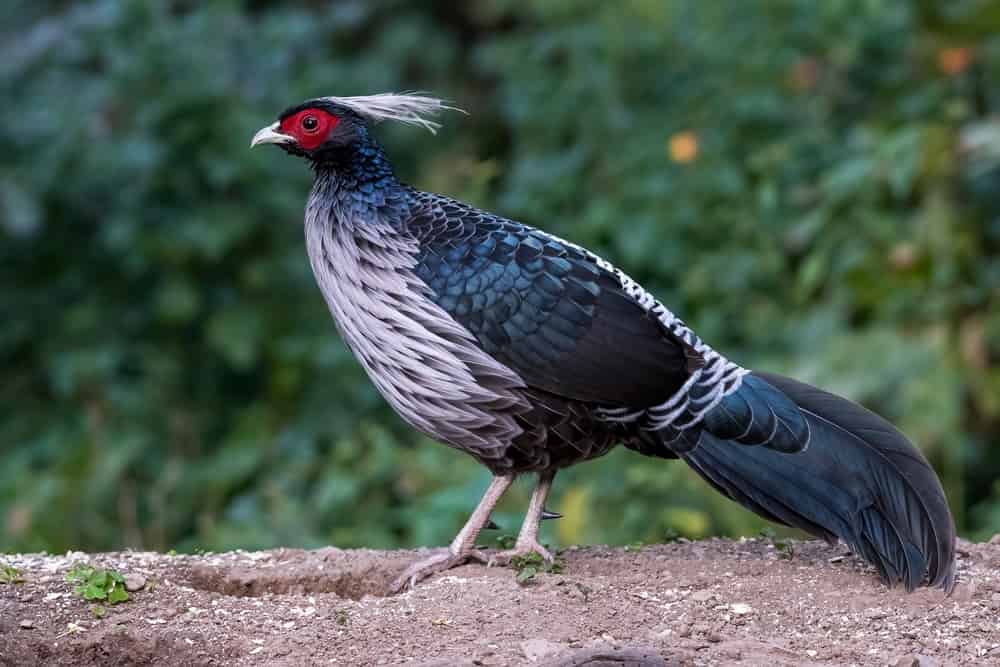 Kalij pheasants are glossy blue-black with white rumps. They also have white or black crests and red skin around their eyes. They live in forests and thickets in the Himalayan foothills.
Kalij pheasants are glossy blue-black with white rumps. They also have white or black crests and red skin around their eyes. They live in forests and thickets in the Himalayan foothills.
The Kalij pheasant is closely related to the silver pheasant and occasionally hybridizes. You will find them in forests and thickets of the Himalayan foothills, with a wide range from Thailand to Pakistan. And there are nine recognized subspecies that inhabit different locations. These wild birds are considered locally abundant and widespread, except for a few subspecies in Myanmar and Thailand, which are threatened. Male Kalij pheasants are glossy blue-black with white rumps. They also have white or black crests and red skin around their eyes. Females are brown with pale edging and occasionally black and white undersides.
Ring-necked Pheasant Ring-necked pheasants are brown and heavily barred with gold and copper. Their heads are iridescent green and purple, and they feature bright red skin around their eyes. Most subspecies also have characteristic white rings around their necks.
Ring-necked pheasants are brown and heavily barred with gold and copper. Their heads are iridescent green and purple, and they feature bright red skin around their eyes. Most subspecies also have characteristic white rings around their necks.
The ring-necked pheasant, also known as the common pheasant, is native to Asia and Europe but has been introduced to many countries around the world as a game bird. It is one of the most hunted birds worldwide and is common on commercial game farms. There are at least 30 subspecies of the common pheasant, and they all have slightly different variations in appearance. On average, though, males are brown and heavily barred with gold and copper. Their heads are iridescent green and purple, and they feature bright red skin around their eyes. Most subspecies also have characteristic white rings around their necks. Females are much duller with overall light-brown plumage and darker barring on the wings.
Lady Amherst’s Pheasant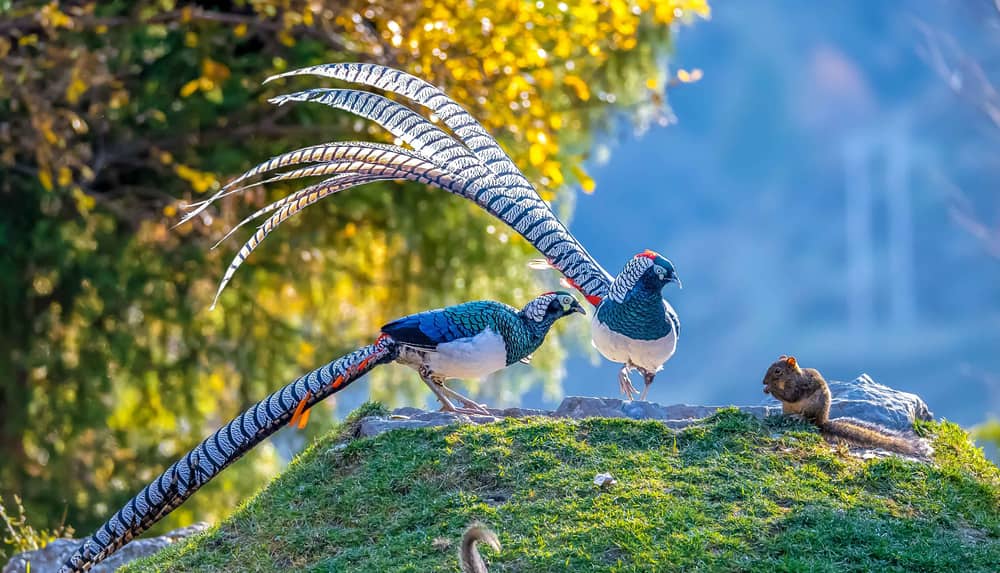 Lady Amherst’s pheasant lives in forested and wooded areas, but you can also find them in bamboo thickets and dense shrub.
Lady Amherst’s pheasant lives in forested and wooded areas, but you can also find them in bamboo thickets and dense shrub.
Named after the British naturalist Countess Amherst, Lady Amherst’s pheasant embodies grace and style. They are native to Southwestern China and Northern Myanmar. However, this species has been introduced to other areas, like England and Scotland. They live in forested and wooded areas, but you can also find them in bamboo thickets and dense shrub. And they feed on the ground, preferring to run when startled than to fly. They also roost in trees at night, much like other pheasants. Males feature a white and black nuchal cape with a red crest. And their bodies are various shades of blue and black, with white below and a black and white tail. Females are dull mottled brown with fine barring.
Reeves’s Pheasant Reeves’s pheasant has one of the longest tail feathers on earth. In their native habitat, they live in temperate evergreen and deciduous forests.
Reeves’s pheasant has one of the longest tail feathers on earth. In their native habitat, they live in temperate evergreen and deciduous forests.
The Reeves’s pheasant is a large species endemic to China. This species has an exceptionally long tail (one of the longest tail feathers in the world) and bright plumage scaled in gold, white, red, and black. And their heads are black and white with scarlet skin around the eyes. Females are much smaller and feature heavily-barred plumage in gray, brown, black, and buff. In their native habitat, they live in temperate evergreen and deciduous forests. They are primarily used for sport in Europe and North America. Fun fact: their tail grows around 12 inches per year!
Mikado Pheasant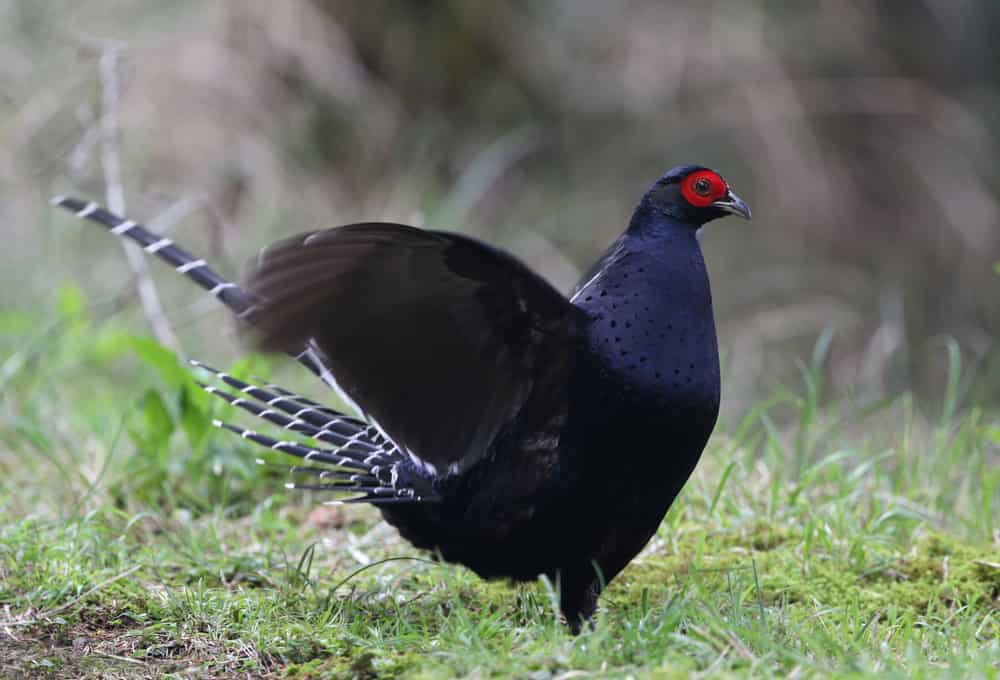 Mikado pheasants are endemic to the mountainous regions of Taiwan. Males are dark and iridescent with white stripes and bright red eye skin.
Mikado pheasants are endemic to the mountainous regions of Taiwan. Males are dark and iridescent with white stripes and bright red eye skin.
The Mikado pheasant is endemic to Taiwan, where it is the unofficial national bird. They inhabit the country’s mountainous regions, living in bamboo, dense shrub, and grassy terrain. They are quiet and solitary, silently stalking toward vegetative cover when disturbed. However, they may move around in the open during times of rain when the mist conceals their movements. They walk and forage for food on the ground, similar to chickens. Males are dark and iridescent with white stripes and bright red eye skin. Females are speckled white and brown.
Himalayan Monal Pheasant The Himalayan Monal is the national bird of Nepal. They live in oak-conifer forests near alpine meadows and cliffs.
The Himalayan Monal is the national bird of Nepal. They live in oak-conifer forests near alpine meadows and cliffs.
The Himalayan monal has a native range from Afghanistan and Pakistan through the Himalayas. They live in oak-conifer forests near alpine meadows and cliffs. It can live at a relatively high elevation in temperate climates, even tolerating snow. They are fairly large pheasants, and the males feature iridescent multi-colored plumage in green, copper, blue, and purple. They have a long crest in metallic green and white rumps only visible during flight. Females are intricately barred in brown and black, featuring prominent white throat patches.
Siamese Fireback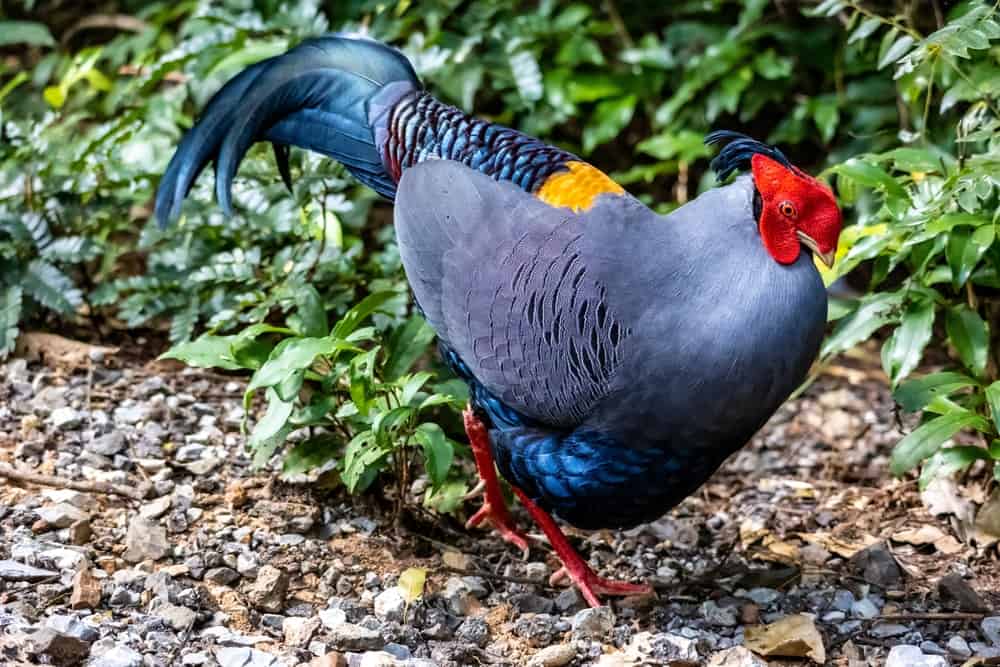 Siamese firebacks inhabit lowland and evergreen forests in their native homes in Southeast Asia. Males feature smooth gray plumage with black crest feathers and crimson caruncles and legs.
Siamese firebacks inhabit lowland and evergreen forests in their native homes in Southeast Asia. Males feature smooth gray plumage with black crest feathers and crimson caruncles and legs.
The Siamese fireback is a relatively large and long pheasant native to Southeast Asia, including Cambodia, Thailand, Laos, and Vietnam. They inhabit lowland and evergreen forests and have suffered severe habitat loss in the past. Fortunately, their populations have recovered and are now listed as least concern. Males feature smooth gray plumage with black crest feathers and crimson caruncles and legs. The females are brown with blackish wings and tails.
Elliot’s Pheasant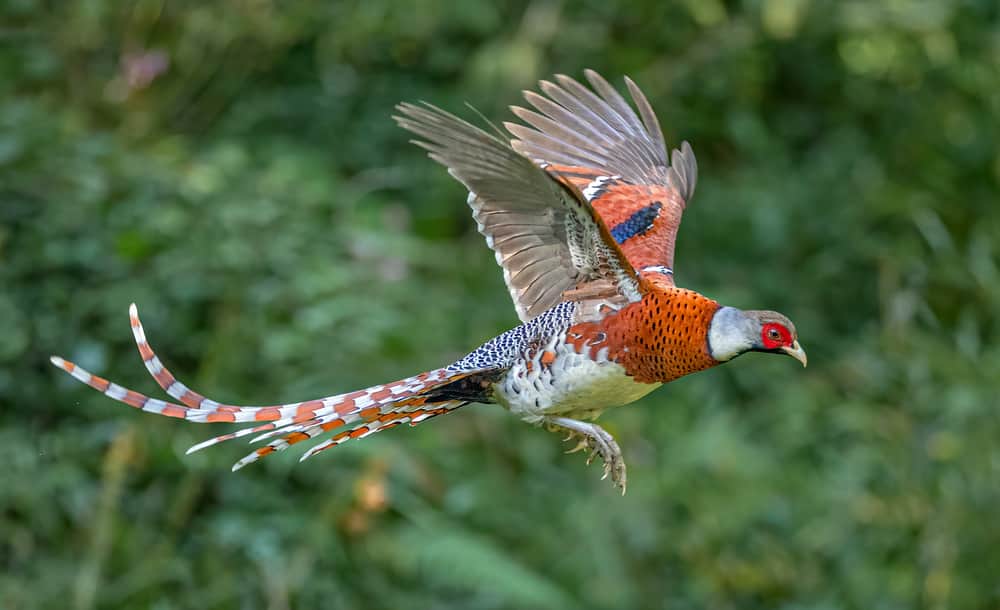 Elliot’s pheasant suffers from habitat loss and hunting pressures, causing them to be listed as near threatened. They live in evergreen and mountain forests in Southeast China.
Elliot’s pheasant suffers from habitat loss and hunting pressures, causing them to be listed as near threatened. They live in evergreen and mountain forests in Southeast China.
Elliot’s pheasant is another large species native to Southeast China, where they inhabit evergreen and mountain forests. This species also suffers from habitat loss and hunting pressures, causing them to be listed as near threatened. Males are chestnut and white with a long barred tail and red facial skin. Females are smaller and feature rufous-colored plumage with black throats.
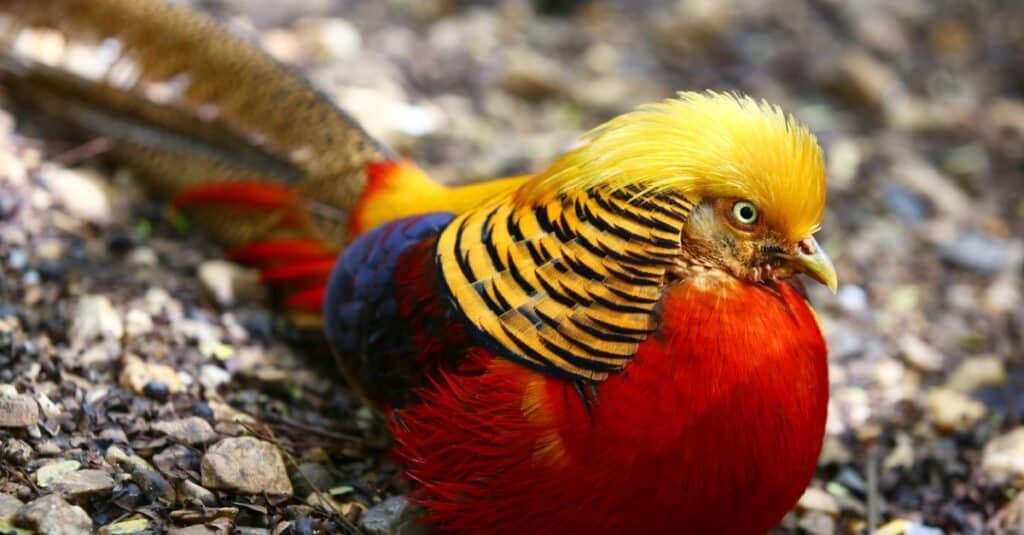
Thank you for reading!








